Exam Details
Exam Code
:300-510Exam Name
:Implementing Cisco Service Provider Advanced Routing Solutions (SPRI)Certification
:CCNP Service ProviderVendor
:CiscoTotal Questions
:210 Q&AsLast Updated
:Mar 27, 2025
Cisco CCNP Service Provider 300-510 Questions & Answers
-
Question 61:
Refer to the exhibit There is a BGP traffic path issue between Customer-1 and Customer-2 Users from Customer-2 have reported file transfer issues High utilization on the path between both customers causes many packet drops.
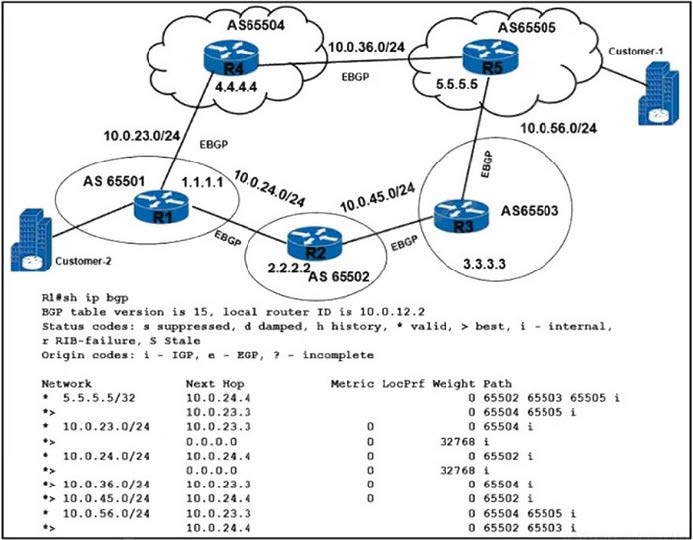
Which configuration resolves the issue?
A. R4#router bgp 65504neighbor 10.0.23.3 remote-as 65501neighbor 10.0.23.3 filter-list 1 outip as-path access-list 1 deny ^65505$ip as-path access-list 1 permit .*
B. R4#router bgp 65504address-family ipv4 unicastneighbor 10.0.23.3 remote-as 65501neighbor 10.0.23.3 activateneighbor 10.0.23.3 route-map PREPEND inexit-address-family
exit
route-map PREPEND permit 10
set as-path prepend 65506 65507
C. R1#neighbor 10.0.23.3 route-map LOCAL-PREF-150 outroute-map LOCAL-PREF-150set local-preference 150
D. R1#neighbor 10.0.24.4 route-map LOCAL-PREF-150 inroute-map LOCAL-PREF-150set local-preference 150ip prefix-list 5-5-5-S seq 5 permit 5.5.5.5/32route-map LOCAL-PREF-150 permit 10
match ip address prefix-list 5-S-5-5
set local-preference 150
-
Question 62:
Refer to the exhibit.

Routers CE1 and CE2 are in AS 65530. which is multihomed for Internet access.
An engineer expects inbound traffic to AS 65530 to arrive from PE1. but it is coming from PE2 instead PE1 and PE2 routers are connected with CE routers through the same bandwidth
Which action must be taken to correct the problem?
A. On router CE2, configure inbound routes from PE2 to CE2 with a local-preference value of 50 or greater.
B. Configure router CEI to prepend the AS path to routes it receives from PE 1.
C. Set the local-preference value on router CEI to 100 or greater
D. On router PEI , change the origin for routes that are redistributed from CEI to CE2.
-
Question 63:
What Is a characteristic of a segment routing mapping server?
A. It must be placed in the core of the network.
B. It serves multiple VRFs.
C. It must have an IGP adjacency.
D. It applies SID mappings from one IGP instance to another IGP instance.
-
Question 64:
Refer to the exhibit.
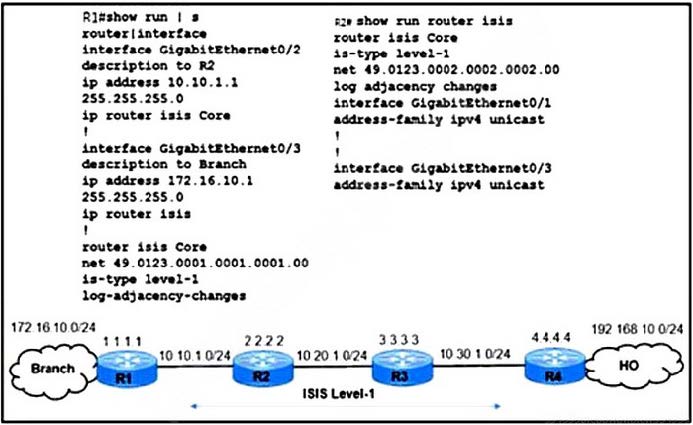
Users at the branch office on R1 reported issue with an application at the home office on R4. While troubleshooting the issue, a network engineer determined that:
1.
The branch-office users can connect to the home office.
2.
The IS-IS adjacencies between R1 and R2 and R1 and the branch office are up.
3.
Traffic from R1 to the R2 10.20.1.0/24 network is moving normally.
4.
The application at the home office is experiencing packet drops on the connection to the Branch, and R3 cannot reach the R1 172.16.10.0/24 network.
Which action resolves the issues?
A. Redistribute static connected routes in IS-IS on router RI.
B. Configure the IS-IS core instance on the RI GigabitEthernet0/3 interface.
C. Redistribute static connected routes in IS-IS on router R4.
D. Configure the IS-IS core instance on the R2 GigabitEthernet0/1 interface.
-
Question 65:
Which difference must an engineer consider when Implementing Inter-domain and Intra- domain multicast routing on the network?
A. Intra-domain routing allows the service provider to control incoming and outgoing multicast data streams on its network, but inter-domain routing limits the service provider's control.
B. Intra-domain routing uses the PIM and MBGP protocols for multicast routing, but inter- domain routing must use PIM.SSM or MSDP.
C. Intra-domain routing is dependent on the RP router within the same SP network, but inter-domain routing reduces the dependency on the other SP network.
D. Inter-domain routing supports policy routing to connect different multicast domains using PIM.SM, but intra-domain routing supports policy routing using PIM-SM only within a single domain.
-
Question 66:
Refer to the exhibit.

Network connectivity between bank A and bank B has been lost Users at bank A and bank B are able to successfully reach their directly connected PE routers.
All routers in OSPF area 0 are correctly advertising and learning routing updates.
Which action resolves the issue?
A. Enable next-hop-self under the iBGP peering configuration on routers PEI and PE2
B. Configure the P routers to redtstnbute BGP routes within OSPF area 0.
C. Configure router PI to advertise the IP prefix of PEI.
D. Configure MPLS with an end-to-end label-switched path on each router.
-
Question 67:
Which type of BGP attribute does a route reflector attach to routes learned from iBGP peers that allows them to be accepted by other iBGP peers, thereby eliminating the need for a full-mesh BGP topology?
A. well-known mandatory
B. optional transitive
C. well-known discretionary
D. optional non transitive
-
Question 68:
Refer to the exhibit
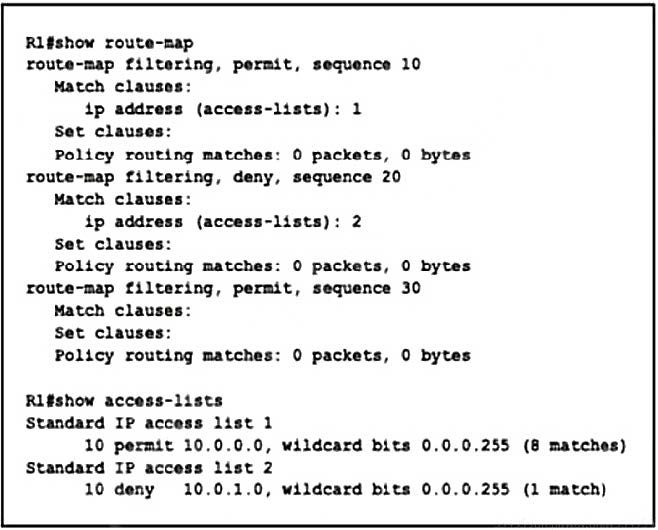
A network engineer configured the redistribute connected subnets route-map filtering command on R1 to redistribute connected interfaces to the OSPF process
The engineer also wants to filter out IP address 10 0 1 0/24. but the prefix still appears in the routing tables of the other routers on the network.
Which action corrects the problem?
A. Remove route-map sequence 30.
B. Add a set statement to route-map sequence 20.
C. Change the deny statement in access list 2 to permit
D. Remove the subnets keyword from the redistribute connected subnets route-map filtering command.
-
Question 69:
Refer to the exhibit.
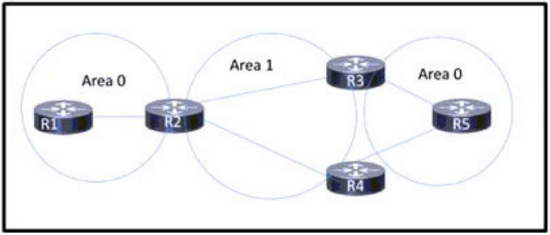
A network engineer just replaced five routers on this OSPF network. When the routing protocol is brought up, R5 cannot reach routes that originate on R1.
The engineer verified that all connected links have established neighbor relationships. R5 reaches routes originating on R3 and R4.
Which action resolves the issue?
A. Configure an OSPF virtual link to bridge Area 0 on routers R3 and R4.
B. Configure automatic neighbor discovery on RI and R5.
C. Configure OSPF to have a contiguous Area O.
D. Configure each link to be point-to-point.
-
Question 70:
Refer to the exhibit.
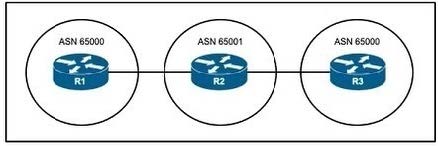
An engineer is troubleshooting an issue with this network and notices that prefixes from R3 are missing on the R1 routing table Due to repeated ASN when the 10 0 0 0'8 prefix from R3 arrives at R1, BGP automatically rejects it There is no prefix-list on R1 which blocks the traffic from R3 What should the engineer do to fix the problem so that BGP allows that prefix on R1?
A. Configure R2 as a route reflector client of R1.
B. Configure the allowas-in command on R1.
C. Configure the next-hop-self command on R2.
D. Configure identical confederation ASNs on R1 and R2.
Related Exams:
300-510
Implementing Cisco Service Provider Advanced Routing Solutions (SPRI)300-515
Implementing Cisco Service Provider VPN Services (SVPI)300-535
Automating and Programming Cisco Service Provider Solutions (SPAUTO)350-501
Implementing and Operating Cisco Service Provider Network Core Technologies (SPCOR)
Tips on How to Prepare for the Exams
Nowadays, the certification exams become more and more important and required by more and more enterprises when applying for a job. But how to prepare for the exam effectively? How to prepare for the exam in a short time with less efforts? How to get a ideal result and how to find the most reliable resources? Here on Vcedump.com, you will find all the answers. Vcedump.com provide not only Cisco exam questions, answers and explanations but also complete assistance on your exam preparation and certification application. If you are confused on your 300-510 exam preparations and Cisco certification application, do not hesitate to visit our Vcedump.com to find your solutions here.